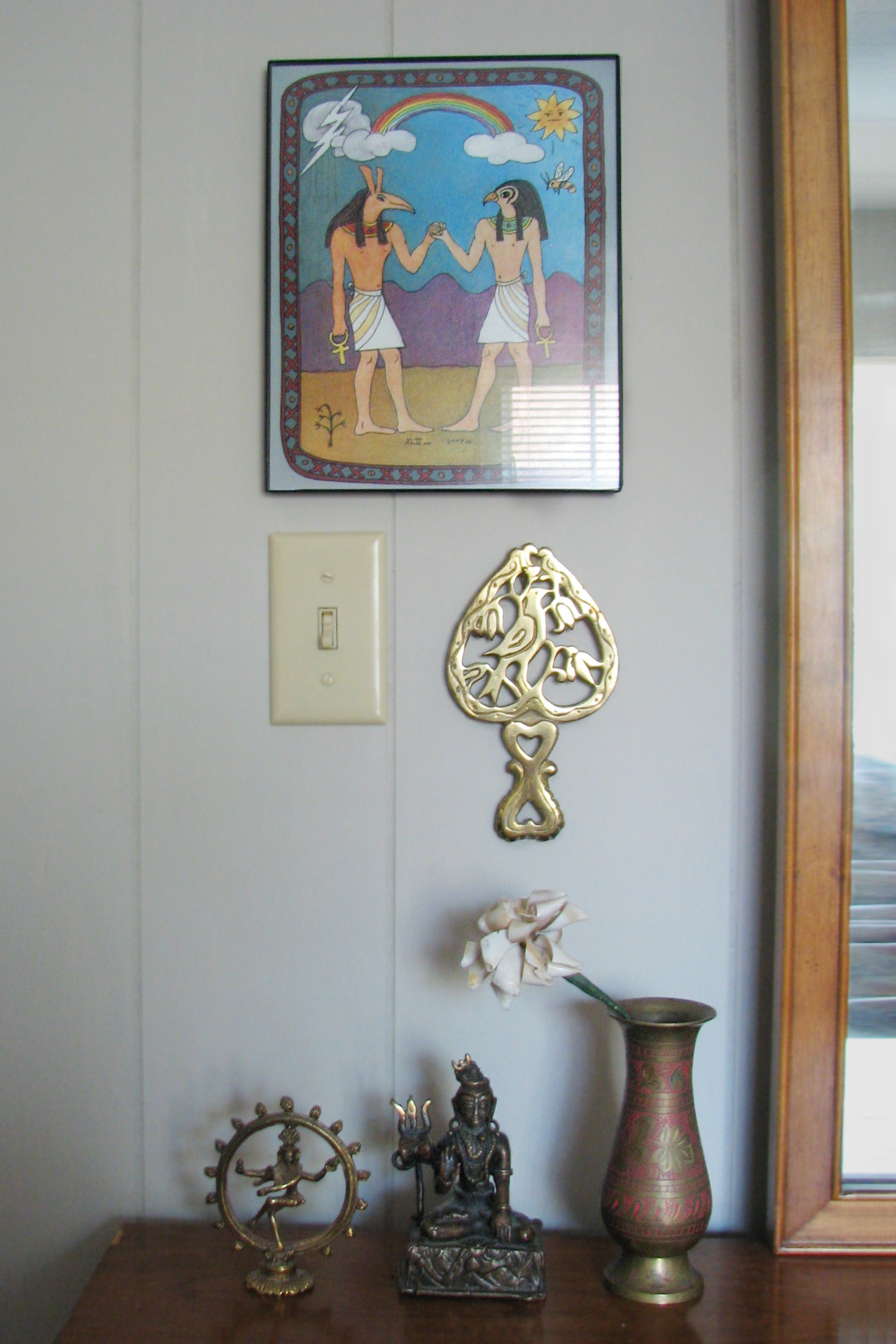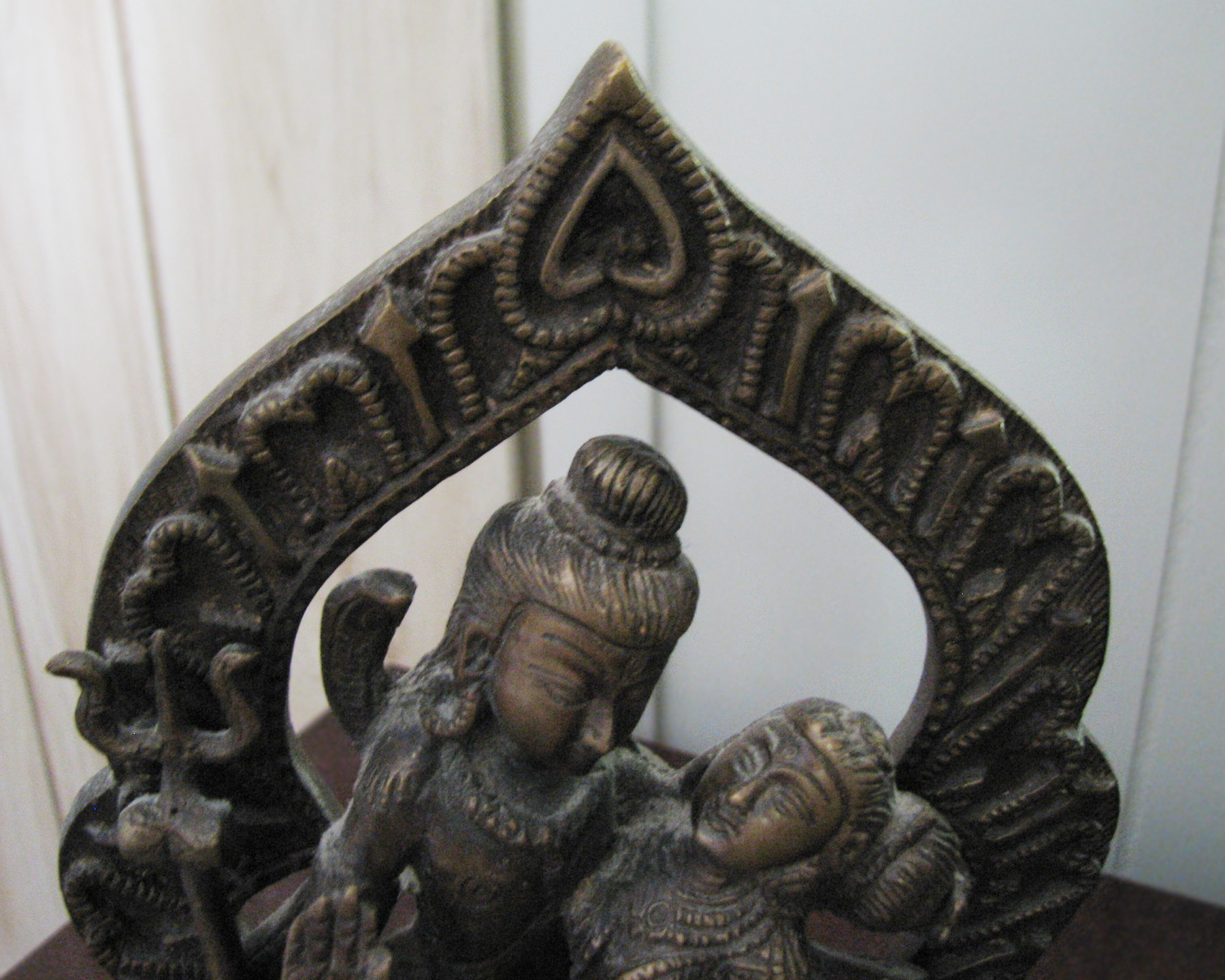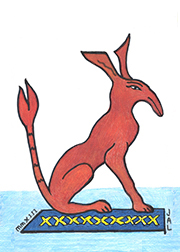|
As I sit here in new house, all around me are boxes in various stages of emptyness.
But I have a few neat areas organized the way I want. At last, I have Khnum on display. I'm aiming for more simplicity, and thus more tranquility, in my arrangements. The above area does have spiritual significance for me. It is neither an 'altar' nor a 'shrine', but it is IS sacred space. Yes, Egyptian Khnum, obelisk, and stylized scarab are combined with an iron dragon and a statue of Shiva and Parvati.
The iron dragon, although not Egyptian, connects to many aspects of the god Set. Iron is a metal associated with Set. Meteorite iron has been called 'the bones of Set'. Alan Alford explains the meteoritic connection with Set, as he quotes the Pyramid Texts, Utterance 21:
“‘O king, I open your mouth for you with the adze of Wepwawet, I split open your mouth for you with the adze of iron (mskhtiu m bja) which split open the mouths of the gods...Horus has split open the mouth of this king with that wherewith he split open the mouth of his father [Osiris]… with the iron which issued from Seth, with the adze of iron which split open the mouths of the gods.’”1
“Ownership of the adze is credited to Wepwawet, while the iron itself is said to have to have issued from Seth. What does this tell us? As regards Seth, it is likely that the text refers to the meteoritic iron of which the adze was made; since the adze was modelled on the northern stars and since Seth was held to dwell in those stars, the iron of the adze would have been viewed as the metal of Seth”2
Also, it could be said, ''Both Set and the Dragon represent '' 'The spirit of the way', bringing eternal change.''
Shiva is another deity who has similarities with Set. When I unpack some more of the things and/or have access to the web, I will find the relevant quotes, not available to me at the present. Shiva is often depicted dancing the dance of creation and destruction, in the process destroying ignorance and forgetfulness. This to me is a very Setian process. The union of Shiva with Parvati for me speaks of the Divine Embrace.
I designed the stylized scarab, which represents Xeper/Kheper, or the Willed Conscious Evolution. Julia got the obelisk, which might be a kind of granite. (In any case, it's real stone.) It's heavy, too, and she got it for me at a consignment store which was near old apartment and she hand carried it over two blocks. The obelisk suggests upwards movement.
The two bells are from my Mother's estate. The claw bell on the right has a very beautiful sound, and so its tones can help cleanse the psychic air, adding to the beneficial environment.
So combined, these pieces have great significance for me.
Here is another area which is meaningful to me:

This arrangement is on the left side of our dresser.
I got the little brass vase on 'my' side of the dresser when I was in college, at a crafts from around the world sale. The Shiva to the left of it came from Sacred Source, one of the last pieces in real bronze they ever sold, I think made in Tibet. The tiny Shiva also came from Sacred Source, many years ago when they were known as JBL statues. The flower in the vase is made of shell and was a gift many years ago from a co-worker who had a vacation in Hawaii. I created the image of Set and Horus reconciled in 2007.
The bird within a heart shape trivet was among my mother's things. I like to think the bird represents Horus. The 'heart' shape of it has added significance beyond the modern 'heart' shape. Richard Reidy explains in Eternal Egypt, for the "General Rite Honoring Sutekh", (another name for Set). One of the things offered to Set is the symbol of his "virile strength", and "The heiroglyph for testicles resembles an inverted Valentine's heart, with tip pointing up and the two rounded halves below." (page 261). That happens to be just the exact shape of this trivet. So it too expresses for me the idea of Set and Horus reconciled and content.
So, yes we have more than surface 'pretty' going on here!
1. Pyramid Texts, translated by R. O. Faulkner, as quoted by Alan F. Alford, Midnight Sun: The Death and Rebirth of God in Ancient Egypt, (Eridu Books 2004), 223.
2. Alford, 222.
Later note:
I was looking at my Shiva and Parvati statue, when I noticed that familiar inverted 'heart' shape!
|


![]()